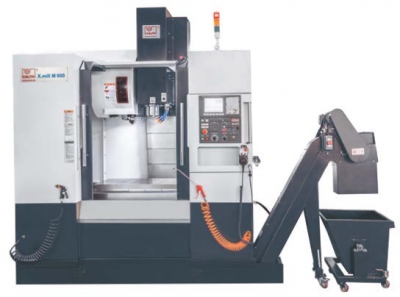
Knuth Machine Tools USA Inc. says its X.mill M 900 provides long life and has a 30-bar ICS system (inside coolant supply).
The machine ensures efficient production and features:
• Mineral-casting machine base with cast-iron stand
• Mineral-casting reduces vibration 6 times faster than cast-iron and up to 10 times faster than steel,
ensuring exceptionally quiet operation, excellent milling capacity and superior
• Superior mechanical properties of the total component package ensure longer tool life
• 10,000-rpm main spindle drive is standard
• Spindle oil-cooler ensures stable thermal conditions during continuous operation
• Precise linear roller guides on all axesfeature reliable stainless steel protective covers
• Precision preloaded ball screws and powerful servo-drives on all 3 axes
• Dual-arm tool changer for quick and precise tool changes
• Enclosed work space ensures safe and contamination-free work
• An electronic hand-wheel and very accessible work table for easy setup of clamping
tools and workpieces
• LED lighting ensures good visibility in the workspace
• Effective coolant system ensures optimal use of tools and excellent chip removal
• An automatic lubrication system reduces the operator’s workload and simplifies
maintenance
• Chain-type chip conveyor with 47 inch high ejector ensures efficient chip removal
Contact Details
Related Glossary Terms
- coolant
coolant
Fluid that reduces temperature buildup at the tool/workpiece interface during machining. Normally takes the form of a liquid such as soluble or chemical mixtures (semisynthetic, synthetic) but can be pressurized air or other gas. Because of water’s ability to absorb great quantities of heat, it is widely used as a coolant and vehicle for various cutting compounds, with the water-to-compound ratio varying with the machining task. See cutting fluid; semisynthetic cutting fluid; soluble-oil cutting fluid; synthetic cutting fluid.
- gang cutting ( milling)
gang cutting ( milling)
Machining with several cutters mounted on a single arbor, generally for simultaneous cutting.
- mechanical properties
mechanical properties
Properties of a material that reveal its elastic and inelastic behavior when force is applied, thereby indicating its suitability for mechanical applications; for example, modulus of elasticity, tensile strength, elongation, hardness and fatigue limit.
- milling
milling
Machining operation in which metal or other material is removed by applying power to a rotating cutter. In vertical milling, the cutting tool is mounted vertically on the spindle. In horizontal milling, the cutting tool is mounted horizontally, either directly on the spindle or on an arbor. Horizontal milling is further broken down into conventional milling, where the cutter rotates opposite the direction of feed, or “up” into the workpiece; and climb milling, where the cutter rotates in the direction of feed, or “down” into the workpiece. Milling operations include plane or surface milling, endmilling, facemilling, angle milling, form milling and profiling.
- milling machine ( mill)
milling machine ( mill)
Runs endmills and arbor-mounted milling cutters. Features include a head with a spindle that drives the cutters; a column, knee and table that provide motion in the three Cartesian axes; and a base that supports the components and houses the cutting-fluid pump and reservoir. The work is mounted on the table and fed into the rotating cutter or endmill to accomplish the milling steps; vertical milling machines also feed endmills into the work by means of a spindle-mounted quill. Models range from small manual machines to big bed-type and duplex mills. All take one of three basic forms: vertical, horizontal or convertible horizontal/vertical. Vertical machines may be knee-type (the table is mounted on a knee that can be elevated) or bed-type (the table is securely supported and only moves horizontally). In general, horizontal machines are bigger and more powerful, while vertical machines are lighter but more versatile and easier to set up and operate.
- payload ( workload)
payload ( workload)
Maximum load that the robot can handle safely.






